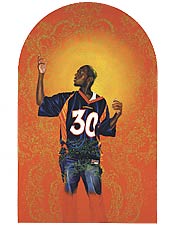
Next month, two accomplished African-American artists come into their own with major solo shows. Kehinde Wiley uses settings familiar to conventional European portrait art—quasi-religious imagery is a frequent stylistic touchstone—and inserts young black men, in contemporary hip-hop attire, into the frame. Kerry James Marshall adopts a more contemporary idiom while exploring similar themes. His best-known project, Rhythm MastR, reworks the pop imagery of comic book art to address black American experience. Marshall says the project grew out of his “lamenting of the absence of African-American heroes.”
Now both artists are moving toward the same sort of mainstream acceptance they imagine freely on their canvases. And not surprisingly, each is keenly attuned to the ironies. “Depending on white collectors and a white-run critical Establishment to reach the highest levels makes for a pretty precarious position,” says Marshall. Yet as that tension persists, both Wiley and Marshall report that mixing “higher” art and vernacular styles permits them a great deal of creative latitude. “The attention span of the viewer today is more geared toward MTV than Titian and Tiepolo,” Wiley says, but “working within the vernacular of the world I live in is inevitable.”
Marshall, too, abjures the hard-and-fast distinctions that traditionally walled off the styles and iconographies he works in. “If the right amount of energy is focused properly, anything is possible,” he says. “In fact, trying to create the same sensation these [canonical Western] artists did is the only really important challenge facing artists of color.”
“Infinite Mobility: The Paintings of Kehinde Wiley” at the Brooklyn Museum of Art, October 5 through February 4, 2005.
Kerry James Marshall’s “One True Thing” at the Studio Museum of Harlem, October 13 through January 9, 2005.